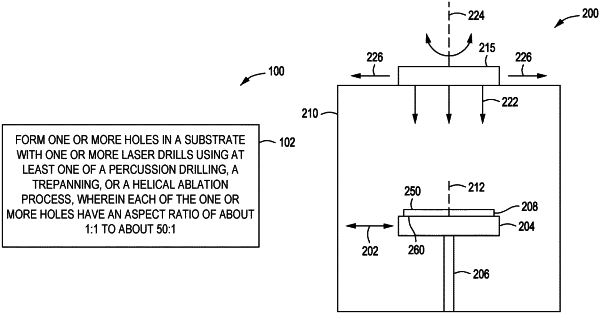| CPC B23K 26/388 (2013.01) [H01L 21/306 (2013.01); H01L 21/67207 (2013.01); B23K 26/0624 (2015.10)] | 15 Claims |

|
1. A method of forming one or more holes in a substrate for use as a process chamber component comprising:
forming the one or more holes in the substrate with one or more laser drills using at least one of a percussion drilling process, a trepanning process, or an ablation process, wherein each of the one or more holes have an aspect ratio of about 1:1 to about 50:1, and wherein the substrate is a component for gas delivery or fluid delivery, wherein the percussion drilling process or the ablation process comprises a pulse duration of about 1.0 nanosecond or less, further comprising:
(1) wherein the substrate has a thickness of about 0.70 mm to about 10.0 mm, wherein the one or more holes are formed from a first side of the substrate to a second side of the substrate, and wherein forming the one or more holes comprises:
forming one or more rough holes through the substrate via the percussion drilling process using the one or more laser drills or a mechanical drilling process; and
using the one or more laser drills to finish the one or more rough holes to form the one or more holes via at least one of the ablation or the trepanning process, wherein finishing the one or more rough holes comprises at least one of reducing a roughness of the one or more rough holes, increasing a roundness of the one or more rough holes, increasing a diameter of the one or more rough holes, or making the one or more rough holes more uniform in diameter with respect to each other, or
(2) wherein the substrate has a thickness of about 10.0 mm to about 20.0 mm, and wherein forming the one or more holes comprises:
using the one or more laser drills to drill first partial holes via an ablation process from a first side of the substrate to a first location disposed between the first side and a second side of the substrate; and
using the one or more laser drills to drill second partial holes via an ablation process from the second side of the substrate to the first location.
|